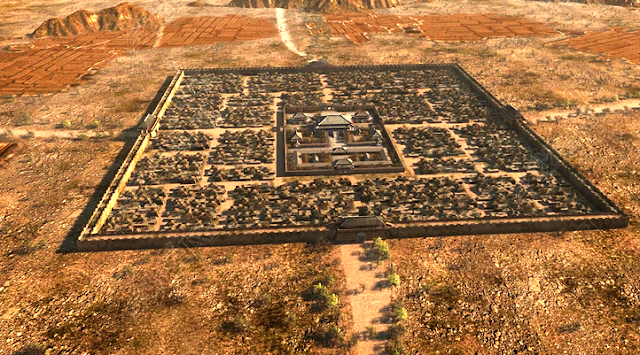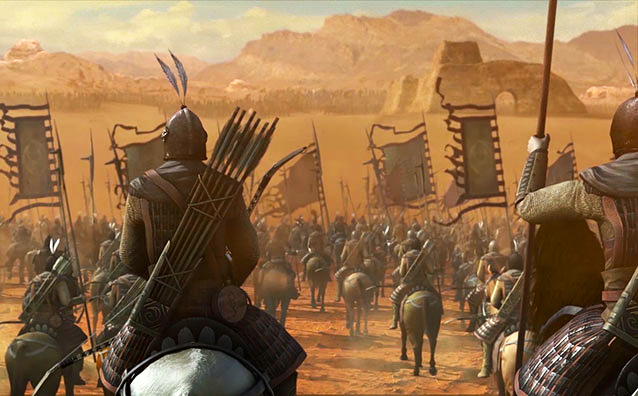Defenses of the Great Wall, The Early Great Wall: 初长城
Music: 《只此青绿》“Only This Lush Green”
The walls were alive. The perennial men within each other's sights and the perennial expanding stone. A long snake that stretched many biomes, from the forbidding windward face of the Taihang Mountains, the endless open steppes, to the burning hell right in the middle of the Taklamakan Deserts. The gate of the kingdom at the world's end. Made when China lacked a natural barrier in its north, so they made a barrier in living stone. So, let there be a wall.
In this chapter we will cover the defensive emplacements around the Great Wall, the military usage of this wall across several Chinese dynasties, and also the defensive networks that revolved around manning this enormous living infrastructure. Most of the information of this first chapter will revolve around the Han dynasty's defenses in particular while the next chapter would be around the Ming. We should of course began with some basics around the origins of this long fortification.
THE NEED: ENEMY AT THE GATES
Wide Open: Northern China's geography for many millenniums had been a geopolitical nightmare. We will instantly notice the broad (and indefensible) northern expanses of flat steppe lands (in white.) Saddled with these lands it meant that northern Chinese kingdoms were always at the mercy of swift and mighty invaders who would have the leisure of choosing where and when to suddenly attack with overwhelming forces.
It was with this ever present danger in mind, that many northern Chinese kingdoms took upon themselves to build a series of man made walls in order to channel invading steppe armies into specially designated kill zones and well reinforced points of contact. Thus, a wall was born, along the northern shields of the vertical stretching Taihang Mountains, and the northern loop of the Yellow River.
Sprouts: A conjoining of defenses. The earliest of what would later become the Great Walls actually started long before the Qin dynasty. By the Warring States period, nearly all of the great states all had long walls which compensated for stretches of their borders that lacked strong natural barriers (even more southern states such as Chu, and Qi.) It should be clearly noted that a lot of what we consider to be the major stretches of the Qin great wall on China's northern frontiers were already constructed by the northern states of Zhao, Yan, and also Qin. After they had violently reunited China in conquest the Qin merely inherited these borders and connected them into one cohesive defensive network.
THE HAN GREAT WALL- OFFENSE & DEFENSE
There were vast expansions to the Great Wall during the Han dynasty, which significantly stretched the walls westward. Instead of being content with the diagonal shape of the Qin Great Walls, as the Han conquered the Hexi Corridor and the Tarim Basin. Soon the Great Wall expanded into those regions as well. Many layers of the wall popped up around the flat northern loop of the Yellow River so that the whole frontier became a fortress (or Barbican) for the Han.

A common misconception was that the Great Walls were usually constructed at a time when the empire was weakened and put on the defensive to entrench the holdings left (mostly owing to the origins of the Ming Great Walls,) however this view is not correct, as during the Han dynasty the Great Walls were actively used for force projection. The walls thus served as a long rally point where both expedition armies could retreat to as well as stage very aggressive invasions into the steppe with a long and defended baggage train.
Music: Warriors (Hero)
Thus it played an active role in Han geopolitics, especially during the ambitious Emperor Wu's nearly 50 years of wars. 30+ years of which were directly dedicated with wars with the Xiongnu. Despite the occasional major battles such as the battle of Mobei, in which massive Han and Xiongnu armies clashed, for the most part much of this bitter war was conducted with deep raids.
Han tomb relief depicting wars between Han soldiers and Xiongnu horse archers. Han soldiers are distinguished by their dotted scale armor surcoat while the Xiongnu are marked by their distinctive conical cap and recurved bow.
It was an unimaginative war with one thing in mind, to grind the Xiongnu until they cannot replenish their strength anymore. In the long run, this grand strategy succeeded and the Han was able to come out on top, for the first time, the Chinese were able to project deep into the steppe. In the wake of the Han control of the Hexi Corridor and the vassalage of the Tarim Oasis- Kingdoms, the Han Great Wall expanded westward to link up those regions and ensured that the thin strip of the Corridor was well fortified, allowing the dynasty to reinforce and control both fringes of the empire.
Art by 陸曼陀 Danling★Lu
East and west: a Han dynasty nobleman and a Tarim nobleman. Left: A Han gentleman in Shenyi 深衣: which were informal robes Chinese men wore in antiquity. This form is known as the zhiju 直裾 and had the robe largely wrapped around the man's body secured by the tight belt. Right: Reconstructed Tarim Mummy, Yingpan Man 营盘美男: possibly a Sogdian trader his face is buried with a white mask. Yingpan Man’s outfit with its Greco-Roman motifs and extravagant embroidery marks him as a man of far-reaching connections. He has Caucasoid features and brown hair.
Han dynasty Great Wall: The wall also extended across the back of the narrow Hexi Corridor and into the Tarim Basin itself, linking with key oasis cities of Loulan (Kroran) and Quici (Kucha.) It is paramount to note that the Tarim lap of the Han Great Walls were built directly into one of the most uninhabitable biomes on planet Earth, right across long stretches of the deadly dune sea of the Taklamakan desert itself. All parts of this network made clever use of the terrain and comprehensively connected northern China in one defense.
In the westward extension of the great wall, the wall was laid into inhospitable deserts. Walls of rammed earth were used in areas where they could not find stone. In other areas, bundles of branches were tied then laid on top of each other mixed with sand. The desert lap was also used to channel enemies and the interior side protected vital springs/ oasis in the arid environment. At key hinges, massive walled garrison cities were built which allowed local armies to swiftly respond to stretches of the wall that reported sighting of major invading armies.
Music: The Black Desert of Kara Korum


The Han Great Walls also was a massive network of signaling posts. After the sighting of major steppe armies fires would be lit and the message would quickly radiate out. These set of signals would then be seen by watch posts within the walls that had messengers with fast houses who will transmit the news back to the local garrisons and summon the major stationed armies.
Han dynasty signal tower/ Guard tower. Composed of a tall lighthouse tower with a brazier ever really to be lit at the first instance of spotting a major approaching horde. To its side are the more mundane castle 坞 quarters which wraps around it in a snail shell shape. There the quarters for off duty guards are located, along with storage spaces for the kindling and oil for the fire.
A digital reconstruction of a powerful Han dynasty fort/ garrison. This particular example does not have crenulated walls (chest high protections) and instead had man height walls with openings for crossbowmen to fire out. Though many other Han dynasty fortifications did have crenulated walls. Key aspect of the fort included a large courtyard where a stationing army could set up camp within and a castle like inner keep that is protected by an even higher set of walls. The gigantic size of the courtyard should be noted when compared to the barracks and stables which appears diminutive within. All of the approaches to the walls are filled with tall spikes to deter enemy approaching in large numbers.
At the gates there is a distinctive L shaped extension- a Han dynasty invention which allowed the defenders to shoot down arrows at the gate besieger's unprotected backs. Furthermore they are positioned to the right side of the gate so that enemies with shields will be forced to defend themselves by putting the shield on their right (thus main) arm and put them at a major disadvantage in melee.
EFFICACY OF THE HAN GREAT WALL
Detractors may point to the fact that the dynasties ultimately became ruined and collapsed as an example of the wall's failure to protect China, but that is entirely a post hoc attribution. In fact, the Han dynasty lasted over 400 years, and was almost as long as the existence of the Roman Empire in the west, and 6.5 of the total lifespan of the Soviet Union. Furthermore, those who toppled the dynasty were not invaders from BEYOND the walls, instead, they were by warlords WITHIN it. At the tail end of the Han dynasty the empire imploded in a series of civil wars in what would become the highly romanticized Three Kingdom period. After 60 years of civil war, eventually the realm did reunite under one dynasty under the Jin. However, in the wake of the Jin dynasty's brief unification of China, the realm was once again threatened by powerful steppe warlords. However, they were not from outside of the walls, instead, they were already inside the Great Walls, for centuries in fact.
Music: Bitter Steppes of the West
ENEMY AT THE GATES
An ethnographic political map of the 5 Hus (the 5 "Barbarians" consisting of the Xiongnu, Xianbei, Jie, Di, and Qiang peoples) - After the destruction of the powerful Xiongnu Confederacy in the early 1st century AD, many Xiongnu tribesmen were settled within the Han Great Walls along the pastures of the northern bend of the Yellow River (light green). The same was done to many other tribes the Chinese dynasties fought with. During the 3 Kingdoms era, the kingdom of Cao Wei and Jin settled many Xianbei (orange) Jie, (black) and Di (yellow) people throughout northern China.
Although the Han was able to eventually completely crush the Xiongnu by the Eastern Han dynasty, the tribes did not completely disappear. Instead, the victorious Han dynasty incorporated many of them into the imperial army as vassals and used them as crack troops deployed within the Great Walls. By the late 3rd century there were several major steppe tribes within and around the Great Walls that were later called the 5 "Barbarians" consisting of the Xiongnu, Xianbei, Jie, Di, and Qiang peoples
However, the imperial government did not completely let them congregate in large numbers, and frequently divided them and deployed them on far off campaigns on opposing fronts of the empire. They served as crack cavalry troops and participated in many of late Han's wars, and also wars of the Three Kingdoms, and the ensuing civil war called the War of the Eight Princes that was fought among various Jin Princes/ imperial uncles.
They sought to destroy each other, destroying each other with soldiery from the steppes, each wielding a kingdom at their disposal. In the end, only these Princes did, all of the princes laid dead after this grand battle royale while steppe Kings sprouted from their vacant states. During the last days of their battle royale, many of their steppe mercenary captains seized power and rapidly established a series of their own states within northern China.
Using their own tribes as a distinguished ruling elite, northern China balkanized into a patchwork of many kingdoms. These steppe warlords would fight for a full century in what would be known as the Sixteen Kingdoms period, before northern China was reunified again. It was after this chaotic period that the Great Walls was ambitious reconstructed again- except this time, the patrons of this new wall were no Han native, instead, the patrons were warlords that were only a century ago from the steppes.
ENEMY MAN THE GATES
Music: The Northern Grasslands
During the extremely chaotic Sixteen Kingdoms Period, the ethnic Xianbei- led kingdom of Dai (later Northern Wei) rose to prominence and defeated the former hegemon of the north- Later Yan. After this was done, they then united all of northern China under its rule in what would become the Northern Wei dynasty. Despite having thoroughly been steppe warlords, they soon faced the same geopolitical realities of northern China, and was quickly on the receiving end of other steppe invaders. When faced with aggressive invasions from the northern steppes against their own holds along the wall, the Xianbei rulers of Northern Wei reinitiated the construction of the Great Wall. The once "enemies" now manned the walls and took up the duty of defending northern China.
To resist the threats poised by the Rourans, Northern Wei emperors started to embark on building its own Great Wall, the first since the Han dynasty. In 423, a defence line over 2,000 li (1,080 kilometers (670 mi)) long was built.
Precarious situation. Astride two worlds. The Xianbei rulers of Northern Wei were very impressed with the culture of the settled Han populace in northern China, and in order to rule the populace, opted to settle much of its nobility within the Great Walls. It was there, right to the south of the Great Walls that they built their new capital at what is today's Datong.
imitates the style of Northern Zhou tomb mural art.
In 446, 100,000 men were put to work building an inner wall from Yanqing, passing south of the Wei capital Pingcheng, and ending up near Pingguan on the eastern bank of the Yellow River. The two walls of Northern Wei formed the basis of the double-layered Xuanfu–Datong wall system that protected Beijing a thousand years later during the Ming dynasty.

Northern Wei army, the armors of the figures are based on tomb figurines from around the Northern Wei period. It was during this era that the famous "Ballad of Mulan" was composed, which describe her fights against steppe invaders from the north. Her story reflected the political realities of the Northern Chinese dynasties. In that they were led and drafted by steppe overlords who had to take up the duty of defending their northern Chinese subjects against further encroachments from other steppe invaders.
Reconstructed model of Datong during Northern Wei: originally merely a fort close to the foothills of the Han- Jin dynasty Great Walls, the Touba chose Datong as the site of their new capital. Due to its extreme proximity to the Great Wall, Datong served as a point for projecting into steppe affairs and govern their subjects on the steppes. The possession of the vast stretches of Han Great Walls allowed Northern Wei to repel many invaders from the north on behalf of the northern populace.
UNDER THE WALL'S SHADOWS
The location had very special significance. Because it was located almost in the shadow of the Great Wall is was a demarcation of 2 different worlds. Beyond the great walls are half of its people, who roam and kept watch on the steppes like in the days of old, however, to the south of their capital are the vast numbers of their Han subjects. Over the generations, the Xianbei emperors and imperial family would increasingly Sinicized and take up the custom of their Han subjects, especially under the influential reigns of the Dowager Empress Hu's tenure. However, this would trigger a massive civil war that would split up the empire in half.
A Northern Wei cavalryman in red rider's cape. He is flanked by a lacquered screen depicting Northern Wei royal lives and court politics.
A powerful Northern Wei general of Xiongnu ethnicity, Erzhu Rong fell out of grace in the court, and holding a deep seated grudge, he mobilized vast number of the steppe armies beyond the Great Walls and, using the pretext that the Sinicized Nothern Wei imperial house had abandoned their ancestral ways, launched an all out genocidal offensive southward against his own government. He was eventually able to prop up a puppet emperor under his own control, but a group of loyalist ministers tricked him into the palace and assassinated him. Erzhu Rong's brutal life and assassination by conspirators strikingly mirrored that of the late Han dynasty regent Dong Zhou and was often compared as such by Chinese historians. Ensuing chaos would eventually rip the Northern Wei in 2, and in time, led to the rise of the Sui and Tang dynasties.
Intrigue eventually unraveled Northern Wei. On an ethnic level, the Touba imperial clan actively embraced Han customs and Han traditions, however, this cultural conversion of "Going native" angered many of the old guards within the Xianbei elites (especially those elements north of the Great Wall)- in time, many rebellions' erupted.
During the Tang and its ensuing centuries, the Great Wall would receive a much different fate than in the Han and Northern Wei eras. A topic which we will cover in detail in the next chapter. Stay tuned.
Music: Through the City Gates
STAY TUNED FOR THE NEXT MAJOR PHASE OF THE GREAT WALL IN PART 2
Thank you to my Patrons who has contributed $10 and above: You made this happen!
➢ ☯ MK Celahir
➢ ☯ Muramasa
➢ ☯ Thomas Vieira
➢ ☯ Kevin
➢ ☯ Vincent Ho (FerrumFlos1st)
➢ ☯ BurenErdene Altankhuyag
➢ ☯ Stephen D Rynerson
➢ ☯ Michael Lam
➢ ☯ Peter Hellman
➢ ☯ SunB



























.jpg)


























Comments